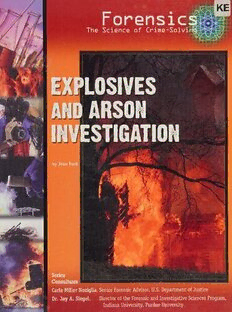Table Of ContentForensi
The Science of Crime-Solvi
LOSIVES
‘ARSON
by Jean Ford ~
ee
Ree ee ees NTE Sraelsesc ea
Carla Miller Noziglia, Senior Forensic Advisor, U.S.o nes of Justice
Dr. Jay A. Siegel, Director of the Forensic and Investigative Sciences Program,
Indiana University, Purdue University.
Digitized by the Internet Archive
in 2022 with funding from
Kahle/Austin Foundation
httos://archive.org/details/explosivesarsoni000Oford
J363.25964 F753 SEP 1 5 2008
Ford, Jean
Explosives and arson
investigation
MID-CONTINENT PUBLIC LIBRARY
Kearney Branch
100 S. Platte-Clay Way
Kearney, MO 64060
are
EXPLOSIVES AND
ARSON INVESTIGATION
RORENSTGNS
THE ©S GEBN Greets
GESOE veaNG
elas eles];
Computer Investigation
Criminal Psychology and Personality Profiling
DNA Analysis
Document Analysis
Entomology and Palynology: Evidence from the Natural World
Explosives and Arson Investigation
Fingerprints, Bite Marks, Ear Prints: Human Signposts
Forensic Anthropology
Forensics in American Culture: Obsessed with Crime
Mark and Trace Analysis
Pathology
Solving Crimes with Physics
EXPLOSIVES AND
ARSON INVESTIGATION
by Jean Otto Ford
Mason Crest Publishers
Philadelphia
i UU
em KE PUBLIC LIBRARY
Kearney, MO 64060
Mason Crest Publishers Inc.
370 Reed Road
Broomall, Pennsylvania 19008
(866) MCP-BOOK (toll free)
Copyright © 2006 by Mason Crest Publishers. All rights re-
served. No part of this publication may be reproduced or trans-
mitted in any form or by any means, electronic or mechanical,
[os
ais including photocopying, recording, taping, or any information
==
storage and retrieval system, without permission from the pub-
i"¢ )
lisher.
bd
==
” First printing
©
onl U253"4, 51097 7819720
Bn
2S AIRNSVOENS TIGATION
bad Library of Congress Cataloging-in-Publication Data
Ford, Jean (Jean Otto)
Explosives and arson investigation / by Jean Otto Ford.
p. cm. — (Forensics, the science of crime-solving)
Includes bibliographical references and index.
ISBN 1-4222-0034-5 ISBN 1-4222-0025-6 (series)
1. Arson investigation—Juvenile literature. 2. Fires—
Juvenile literature. 3. Explosions—Juvenile literature. I. Title.
IT. Series.
HV8079.A7F67 2006
363.25'964—dc22
2005017229
Produced by Harding House Publishing Service, Inc.
www. hardinghousepages.com
Interior and cover design by MK Bassett-Harvey.
Printed in India.
Contents
Introduction 6
1. Igniting Interest: The Basics 9
2. Where There’s Smoke...:The Scene 27
MO
3. Too Hot to Handle: The Evidence 49
Oo
=
4, Burning Questions: Accident or Crime? 65 ct
1)
5. Fire Starters: Common Motives 93 =
ct
Glossary 106 “
Further Reading 107
For More Information 108
Index 110
Picture Credits 111
Biographies 112
Introduction
By Jay A. Siegel, Ph.D.
Director, Forensic and Investigative Sciences Program
Indiana University, Purdue University, Indianapolis
ea It seems like every day the news brings forth another story
as
about crime in the United States. Although the crime rate has
<=
been slowly decreasing over the past few years (due perhaps in
”
had part to the aging of the population), crime continues to be a
=
very serious problem. Increasingly, the stories we read that in-
”
i) volve crimes also mention the role that forensic science plays
oxadl
in solving serious crimes. Sensational crimes such as the 0. J.
As
ba IANRVSEOSNT IGATION Simpson case, or more recently, the Laci Peterson tragedy, pro-
bad
vide real examples of the power of forensic science. In recent
years there has been an explosion of books, movies, and TV
shows devoted to forensic science and crime investigation. The
wondrously successful CSI TV shows have spawned a major in-
crease in awareness of and interest in forensic science as a tool
for solving crimes. CSI even has its own syndrome: the “CST
Effect,” wherein jurors in real cases expect to hear testimony
about science such as fingerprints, DNA, and blood spatter be-
cause they saw it on TV.
The unprecedented rise in the public’s interest in forensic
science has fueled demands by students and parents for more
educational programs that teach the applications of science to
crime. This started in colleges and universities but has filtered
down to high schools and middle schools. Even elementary
school students now learn how science is used in the criminal
justice system. Most educators agree that this developing inter-
est in forensic science is a good thing. It has provided an ex-
cellent opportunity to teach students science—and they have
fun learning it! Forensic science is an ideal vehicle for teach-
ing science for several reasons. It is truly multidisciplinary;

